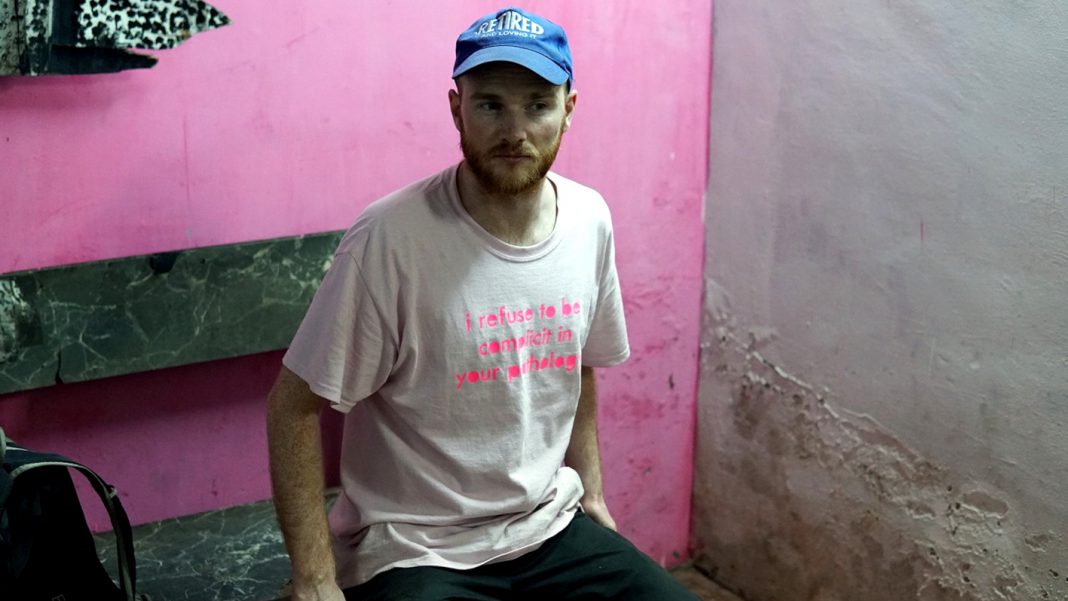
Photo: Fred Durst (Rian Treanor)
Rian Treanor makes music that is highly unconventional precisely because the producer’s music plays with conventional forms. Warping and twisting the „formulaic,“ as he himself puts it, his records for labels like The Death of Rave and Planet Mu sounds oddly familiar and positively alienating at the same time. The latter’s founder, Mike Paradinas a.k.a. µ-ziq, unconventionally also mixed this contribution to the Groove podcast, a mix chock-full of previously unreleased material or alternative versions of the tracks you find on Treanor’s new album File Under UK Metaplasm.
First off, how are you doing and what have you been up to in the past months?
I’m okay despite everything, really. I had some time off music at the start of quarantine, but over the past few months I’ve started to focus on some new projects. I have been doing a bunch of workshops these past few weeks, one with a group of 10-11-year-olds at No Bounds Festival in Sheffield, another one commissioned by Les Siestes Electroniques with a group at a retirement home in Paris. Last weekend I did a remote performance with Mark Fell and dancer Justin Kennedy at Haus der Kulturen der Welt in Berlin as part of a CTM Festival event. All these use some software I’ve been developing with Mark that enables remote participation in different ways. We have been building various stand alone apps that contain musical devices that people can play together in real time over a network. We are currently working on a number of different outcomes which we are calling Inter-symmetric works. These include workshops, live performances, installations and critical discussions. Exploring the musical possibilities of remote participation, with a focus on exploratory forms of networked interaction between audiences and collaborators.
You have worked at Dubplates & Mastering. What did you learn there?
I wouldn’t say I worked at Dubplates exactly, I just did work experience there. I worked with LUPO though which was amazing, I sat through all his sessions and just observed wide-eared. I wasn’t that technically aware then so I couldn’t ask the really insightful questions but some of it sank in. Looking back the most important thing I took from it is the process of reduction. How stripping things away can give you more impact. How it’s like creating a sculpture from stone, you have to chip away to bring out the defining features.
Max/MSP is crucial in your working process. Why do you prefer it over DAWs like Ableton?
I make music using all sorts of equipment, everything has its own personality and use. Max/MSP enables me to explore and develop things at a lower level. I use it to build bespoke devices to create weird rhythmic structures, I’m really interested in developing processes that enable spontaneous and impulsive ways to modulate patterns live. It’s amazing because you can use the small and relatively simple components to build bigger more complex systems, each object has a help file so you can chop things together quite easily once you’ve got the gist of it. It’s just like lego or something. I do use Ableton a lot, too, mostly for editing MIDI and WAVs. The timeline is great for certain purposes but it can sometimes be quite challenging. When working in Max I find it’s more like jamming around on an instrument in real time. Rather than composing a piece and watching the play head move through something you have already pre planned. Max feels a bit more in the moment somehow, it’s like the composition is made as it’s happening.
You’ve spent a month in Kampala at Nyege Nyege’s Boutique Studio in 2018 for a residency there and worked closely with Acholi fiddle player Ocen James. What exactly were the two of you working on?
We were working in collaboration to develop a new live show for the festival in Jinja. We recorded a load of stuff too, mostly Ocen on fiddle and me doing electronic rhythm. I love the ideas that come out of the collision between different practices, I was really into how these two very different but simple components could interact and hopefully find some sort of meaningful dialogue. We both come from really different musical backgrounds, Ocen is an amazing Acholi fiddle player, he is a master at his craft. His awareness of traditional Acholi music is incredible and unparalleled, I think. But he also makes electronic music with Otim Alpha and Leo Palayeng Kenna who have pioneered Acholitronix music – a new electronic form of traditional Acholi ceremonial music. It’s all 160bpm, it is literally the best 4/4 techno music I’ve ever heard. It’s incredible and so much fun to dance to. The studio there is a crazy hive of activity too, there were around 30 or so artists from all over collaborating in various combos, it was an amazing opportunity to take part in and endlessly inspiring. There were people from all over, Sisso, Jay Mitta, Modern Institute, Errorsmith, Slikkback, Morgiana HZ, Still, HHY, the Nihiloxica crew, Leo Palayeng and all the Hakuna Kulala crew. It’s a melting pot, people making stuff and setting up temporary studios in every single room. Everyone throwing in ideas and stirring it all together. Everyone had some kind of a part to play in each others creative process, it’s a really intense place and has a crazy energy that pushes you to make the wildest stuff. My new record is a kind of response to that time.
The singeli sound of Tanzania was especially influential for you during that time. What is in particular that is so fascinating for you?
The first time I heard Singeli was through Conor Thomas who runs The Death of Rave at a gig we played together at Saule in Berlin. He played some of the then unreleased Sounds of Sisso compilation from 2017, I had no idea what it was but I was instantly hooked. It completely blew me away, so raw and direct. It’s just unbelievably moving. He invited me to support Bamba Pana and Makaveli at one of their first gigs outside Africa. It was an incredible set, the type of thing that just makes you reconsider everything. You see it going down live and peoples’ bodies just can’t deal with it, it’s like a physical reaction, you can’t comprehend it but once it sets in that’s that. The whole time I was just thinking how the hell do you follow that. Then at Nyege Nyege festival in 2018, there was a crew of about 15+ Singeli artists that came up from Tanzania. Totally ace seeing their crew do it, some mental dance moves, was so much fun. There is some footage on Boiler Room that gives a good impression but they were at it all weekend. We had some time in the studio after the festival, Sisso and Jay Mitta were working with Modern Institute and Errorsmith on a tape they put out last year. It was really insightful seeing how they make stuff, really rough and immediate. Using stuff like Virtual DJ to remix and chop things together on the fly. They’re basically recording in real-time, tracks literally take minutes to make. Totally punk. We ended up playing some gigs together and it’s like you either have to play fast or you might as well pack your bag, you know. I remember playing some slow track that pretty much cleared the dance floor. I basically spent the next year trying to make music that could keep up.
Your new record’s called File Under UK Metaplasm, „metaplasm“ being a term describing alterations of words in how they are written or pronounced. You have also said that you were using „formulaic dance structures but just slightly mangled or messed up.“ What potential do you see in this approach, what was your goal when experimenting with these formulaic structures?
I’m interested in making things based around existing musical processes and learning about how things fit together. I love a lot of music that radically opposes musical orthodoxy but my main interest is music that is as weird as it is danceable. So I use standard things like percussion patterns and chord or bassline, using basic things like a step sequencer or harmonic scale, etc. But it’s like, how do you use that formula but do it in a way that isn’t formulaic? How do you find a balance between things so it’s not just nonsense? I’m interested in using systems but pushing them to their extremes or turning them on their head somehow. Making something normal sound weird or making something weird sound normal. I think I get bored easy and I find it exciting to mess about with things. I’m inspired by loads of disparate stuff but for me it’s like how can I make sense of it on paper. How can I articulate that or connect points in an interesting way or in a way that it might make sense for someone else. All the structures that I choose to work with are just part of a system and a lineage that I find really engaging, that I would like to explore or try to get to grips with in more detail. And hopefully add something new to the conversation. I love to find new music as a listener and I guess I have a similar approach in the studio… what happens when you put different components together or reinterpret stuff. It’s sort of like unearthing things. All music is building on pre-existing structures, ideas and languages. It’s a dialogue, it’s just some of it is either excessively obscure or some of it is tediously uninventive. It’s a fine line too. I guess my goal was to take some personal influences and put them together in a different way that hopefully other people could like too. But that’s the approach that everyone has, isn’t it?
Somewhat unusually, your contribution to the Groove podcast was mixed by someone else, Planet Mu label founder Mike Paradinas. It features previously unreleased music. What can you tell us about the material that we’re hearing?
All these tracks are things I made when I was working on this album, there are various unreleased tracks and alternative versions of stuff. They are all part of the same body of work, I guess, or all part of that moment in time for me. Mike suggested to put them together in a mix, so he did.
Last but not least: what are your plans for the future?
I’ve got a workshop/performance coming up at Somerset House in London in a few weeks, so I’m really busy on that. Other than that I am planning to stay home until next spring before I consider any new travel plans, etc. Let’s see, I usually hibernate over winter and make loads of music anyway.
Stream: Rian Treanor – Groove Podcast 274
01. Untitled 1
02. Untitled 2
03. Untitled 3
04. Untitled 4
05. Metrogazer
06. Hypnic Jerks
07. Obstacle 2
08. Vacuum Angle
09. Obstacle 1
10. Yazoo
11. Metaplasm
12. Debouncing
13. Untitled 5
14. Untitled 6
15. Untitled 7
16. Mirror Instant
17. Obstacle 3
18. Orders From The Pausing
19. Opponent Process
20. Closed Curve
![[REWIND 2025]: Die Top 5 der Autor:innen](https://groove.de/wp-content/uploads/2025/12/rewind-2025-die-top-5-der-autorinnen--218x150.jpg)
![[REWIND 2025]: Kuratorin Charlotte Knaup über Berlin Beats im Hamburger Bahnhof: „Da gibt es so viel Raum, so viel Luft und so viel Reibung, die wir uns anschauen wollen”](https://groove.de/wp-content/uploads/2025/12/Berlin-Beats_Charlotte-Knaup-als-Kuratorin-vom-Hamburger-Bahnhof-218x150.jpg)


